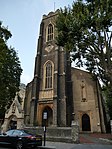Cavalry of the Empire Memorial
1924 establishments in England1924 sculpturesBritish military memorials and cemeteriesBuildings and structures completed in 1924Buildings and structures in Hyde Park, London ... and 10 more
EngvarB from September 2017Equestrian statues in the United KingdomGrade II* listed monuments and memorialsGrade II* listed statues in the City of WestminsterMilitary memorials in LondonMonuments and memorials in LondonOutdoor sculptures in LondonSaint George (martyr)World War II memorials in EnglandWorld War I memorials in England

The Cavalry of the Empire Memorial, also known as the Cavalry Memorial, is a war memorial in Hyde Park, London. It commemorates the service of cavalry regiments in the First and Second World Wars. It became a Grade II listed building in 1987, and was promoted to Grade II* in November 2014.
Excerpt from the Wikipedia article Cavalry of the Empire Memorial (License: CC BY-SA 3.0, Authors, Images).Cavalry of the Empire Memorial
Serpentine Road, London Knightsbridge
Geographical coordinates (GPS) Address External links Nearby Places Show on map
Geographical coordinates (GPS)
| Latitude | Longitude |
|---|---|
| N 51.50469 ° | E -0.15526 ° |
Address
Cavalry of the Empire
Serpentine Road
W2 2UH London, Knightsbridge
England, United Kingdom
Open on Google Maps








